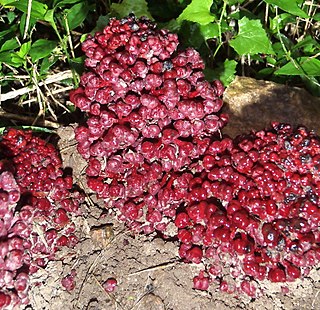
Meliaceae, the mahogany family, is a flowering plant family of mostly trees and shrubs in the order Sapindales.

Cedrela is a genus of several species in the mahogany family, Meliaceae. They are evergreen or dry-season deciduous trees with pinnate leaves, native to the tropical and subtropical New World, from southern Mexico south to northern Argentina.

Azadirachta is a genus of two species of trees in the mahogany family Meliaceae. Numerous species have been proposed for the genus but only two are currently recognized, Azadirachta excelsa and the economically important tree Azadirachta indica, the neem tree, from which neem oil is extracted. Both species are native to the Indomalaysian region, and A. indica is also widely cultivated and naturalized outside its native range.

Entandrophragma is a genus of eleven known species of deciduous trees in the family Meliaceae.

Guarea is a genus of evergreen trees or shrubs in the family Meliaceae, native to tropical Africa and Central and South America. At their largest, they are large trees 20–45 m tall, with a trunk over 1 m diameter, often buttressed at the base. The leaves are pinnate, with 4–6 pairs of leaflets, the terminal leaflet present. They are dioecious, with male and female flowers on separate plants. The flowers are produced in loose inflorescences, each flower small, with 4–5 yellowish petals. The fruit is a four or five-valved capsule, containing several seeds, each surrounded by a yellow-orange fleshy aril; the seeds are dispersed by hornbills and monkeys which eat the aril.

Dysoxylum is a flowering plant genus of trees and shrubs from the mahogany family, Meliaceae.

Tofieldiaceae is a family of flowering plants in the monocot order Alismatales. The family is divided into four genera, which together comprise 28 known species. They are small, herbaceous plants, mostly of arctic and subarctic regions, but a few extend further south, and one genus is endemic to northern South America and Florida. Tofieldia pusilla is sometimes grown as an ornamental.

Argemone is a genus of flowering plants in the family Papaveraceae commonly known as prickly poppies. There are about 32 species native to the Americas and Hawaii. The generic name originated as ἀργεμώνη in Greek and was applied by Dioscorides to a poppy-like plant used to treat cataracts.

Turraea is a genus of plants in the family Meliaceae, native to the Old World tropics and subtropics.

Melia is a genus of flowering trees in the family Meliaceae. The name is derived from μελία, the Greek name used by Theophrastus for Fraxinus ornus, which has similar leaves.

Carl Gustaf Ekeberg was a Swedish physician, chemist and explorer. He made several voyages to the East Indies and China as a sea captain. He brought back reports of the tea tree and wrote a number of books.

Dolomiaea is a genus of Asian flowering plants in the family Asteraceae.

Ekebergia capensis is a tree in the family Meliaceae. It is commonly known as the Cape ash. Its range extends from the Eastern Cape of South Africa to Sudan and Ethiopia. It has been introduced onto Ascension Island.

Chisocheton is a genus of trees in the family Meliaceae. The genus name comes from the Greek schizos and chiton meaning "split tunic", referring to the lobed staminal tube of C. patens. Their range is from India and tropical China, throughout Malesia and south to New South Wales and Vanuatu.

Cabralea is a genus of trees in the family Meliaceae. It has one species, Cabralea canjerana. It is dioecious, with male and female flowers on separate plants.

Munronia is a genus of flowering plants in the family Meliaceae. Its native distribution is tropical and subtropical Asia.

Sarcophyte is a genus of flowering plants belonging to the family Balanophoraceae.
Heckeldora is a genus of flowering plants belonging to the family Meliaceae. They are shrubs or small trees with odd-pinnate leaves. Plants are dioecious, with male and female flowers on separate plants.
Humbertioturraea is a genus of flowering plants belonging to the family Meliaceae.
















